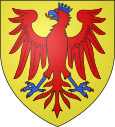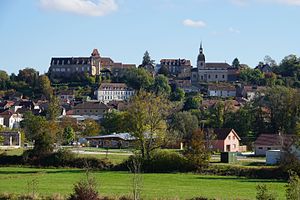Rougemont (Doubs)
| Rougemont | ||
|---|---|---|

|
|
|
| region | Bourgogne-Franche-Comté | |
| Department | Doubs | |
| Arrondissement | Besançon | |
| Canton | Baume-les-Dames | |
| Community association | Deux Vallées Vertes | |
| Coordinates | 47 ° 29 ′ N , 6 ° 21 ′ E | |
| height | 245-405 m | |
| surface | 18.33 km 2 | |
| Residents | 1,124 (January 1, 2017) | |
| Population density | 61 inhabitants / km 2 | |
| Post Code | 25680 | |
| INSEE code | 25505 | |
| Website | www.rougemont-doubs.fr | |
 View of Rougemont |
||
Rougemont is a French commune with 1,124 inhabitants (as of January 1 2017) in Doubs in the region Bourgogne Franche-Comté . It belongs to the canton of Baume-les-Dames in the arrondissement of Besançon .
geography
Rougemont is located at an altitude of 260 m above sea level, 14 kilometers north of Baume-les-Dames and about 34 kilometers west of the city of Montbéliard (as the crow flies). The town extends on the southern edge of the Ognon valley , on both sides of its tributary Drigeon and on a promontory of Montaucivey at the north foot of the hilly landscape between the valley lowlands of Doubs in the south and Ognon in the north.
The area of the 18.33 km² large municipal area includes a section of the central Ognontal. The central part of the area is crossed in an east-west direction by the wide valley basin of the Drigeon, which provides drainage to the Ognon. At Rougemont this valley is temporarily narrowed by the protrusion of the Schlossberg, a foothill of the Montaucivey, and the Rougemontot ( 310 m ). To the south, the community area extends into the more strongly reliefed landscape of the hills between the Ognon and Doubs. These include the Montaucivey, an elongated, wooded ridge on which the highest point of Rougemont is reached at 404 m, and the Mont Adam.
The western and northern parts of the municipality show only slight differences in relief. This section is characterized by the lowland of the Ognon, which extends here in a large arc far to the southeast, and the adjacent hills. These are partly made up of arable land and meadow, partly of forest. The Bois Grand Juif and the Bois de la Corne are among the region's large forests . In the far north, the municipality extends into the valley of the Ruisseau de l'Étang , another tributary of the Ognon.
The municipality of Rougemont includes various districts, namely:
- La Tuilerie ( 260 m ) on the northern edge of the Drigeon valley
- Chazelot ( 255 m ) on the southern edge of the Drigeon valley
- Montferney ( 255 m ) at the confluence of the Drigeon in the Ognon
- Morchamps ( 295 m ) in a valley basin at the north foot of Mont Adam
Neighboring municipalities of Rougemont are Thieffrans , Tressandans , Bonnal and Pont-sur-l'Ognon in the north, Cubrial , Cuse-et-Adrisans and Gondenans-les-Moulins in the east, Gouhelans and Puessans in the south and Mondon and Montagney-Servigney in the west.
history
The area around Rougemont was populated very early. Traces from the Neolithic have been found in various caves in the area . Numerous coin finds, brick fragments and pieces of jewelery date from the Gallo-Roman period. A Burgundian burial ground was discovered to the west of the town; Various rich grave goods are now in the Museum of Besançon.
The place name of Rougemont goes back to the Latin Rubeomonte (red mountain) in reference to the reddish color of the iron-bearing rock. The local history of Rougemont begins in the 9th century. At that time the first castle complex was built, which controlled the route between Ognon and Doubs. A settlement developed at this facility. The von Rougemont family has been documented since the early 11th century. The rulership of Rougemont formed a powerful and influential rulership under the Counts of Burgundy. Three family members, Gérard, Eudes and Thiébaud of Rougemont, became archbishops of Besançon. The Rougemont settlement was fortified in the 12th century. The town became an important spiritual center at the beginning of the 15th century when Thiébaud founded the Minorite monastery .
After the line of the Rougemont family had expired with Thiébaud, the town underwent various changes of ownership. Rougemont has been affected by wars and fires several times. In 1476 it was conquered during the Burgundian Wars by the Counts of Ferrette together with the Swiss and then in 1479 by the troops of Louis XI. destroyed. In 1636, Rougemont suffered severe damage during the Thirty Years' War. The castle gradually fell into disrepair and the town lost its importance. The castle wall with the four gates was also devastated. Together with Franche-Comté , Rougemont finally came to France with the Peace of Nijmegen in 1678. In the course of the 18th century, the fortifications with the city gates were abandoned and mostly removed.
With the opening of the railway line from Lure to Montbozon , Rougemont was connected to the French rail network in 1896. The area changed in 1973 when the previously independent municipalities of Chazelot, Montferney and Morchamps were incorporated into Rougemont. Today Rougemont is a member of the Deux Vallées Vertes municipal association .
Attractions
The small town at the foot of the Schlossberg still shows a medieval townscape with narrow streets, flanked by town houses from the 16th to 19th centuries. The Mairie (town hall), the former granary (both from the 19th century) and other town houses are grouped around the main square with the fountain and the lavoir. The Porte du Vieux Moulin and bridges over the Drigeon from the 18th century have also been preserved. Rougemont has two museums: the Musée de Paléontologie (archaeological finds from the region) and the Musée de la Maison vigneronne d'autrefois in an 18th-century house showing rural life in the 19th century.
On the ledge above the old town are the Château de Vorget (building mostly from the 18th century), the former Minorite monastery (partly from the 16th century) and the church, which partly dates from the 15th century; the ship was rebuilt in the 18th century. The rich interior includes various statues from the 15th and 16th centuries, as well as a cross donated by Thiébaud de Rougemont (15th century).
Other attractions include the Chapelle de Montaucivey (inaugurated in 1855), which stands on the ridge north of the hill of the same name and is considered a beautiful vantage point, and the Chapelle Saint-Hilaire (in the cemetery of Chazelot and Montferney).
population
| Population development | |
|---|---|
| year | Residents |
| 1962 | 878 |
| 1968 | 916 |
| 1975 | 1110 |
| 1982 | 1179 |
| 1990 | 1200 |
| 1999 | 1233 |
| 2004 | 1232 |
| 2016 | 1168 |
With 1,124 inhabitants (as of January 1, 2017), Rougemont is one of the smaller communities in the Doubs department. After the population in the first half of the 20th century was mostly in the range between 900 and 1000 people, a population growth was recorded during the 1970s. Since then there have only been relatively minor fluctuations.
Economy and Infrastructure
Early on, Rougemont was a town characterized by trade, industry and the processing of agricultural products in the area. Today Rougemont performs central functions for the surrounding area and has a well-developed infrastructure.
In recent years, a commercial and industrial zone has been created east of Rougemont. The food industry, mechanical workshops and wood processing are mainly represented in the village. There are numerous other jobs in the tertiary sector, in a supermarket, many retail outlets and in the tourism and hospitality industry. Rougemont has a cultural center, a college, a retirement home (in the castle buildings) and a center for the integration of the disabled into society.
Rougemont has good transport links. It is close to the main D50 road from Baume-les-Dames to Villersexel . The closest connection to the A36 motorway is around 17 kilometers away. Other road connections exist with Avilley , Cognières , Tressandans, Bonnal and Gouhelans.
Personalities
- Humbertus Guilielmus de Precipiano (1627–1711), bishop and government official
literature
- Le Patrimoine des Communes du Doubs. Volume 2, Flohic Editions, Paris 2001, ISBN 2-84234-087-6 , pp. 1123-1127.

